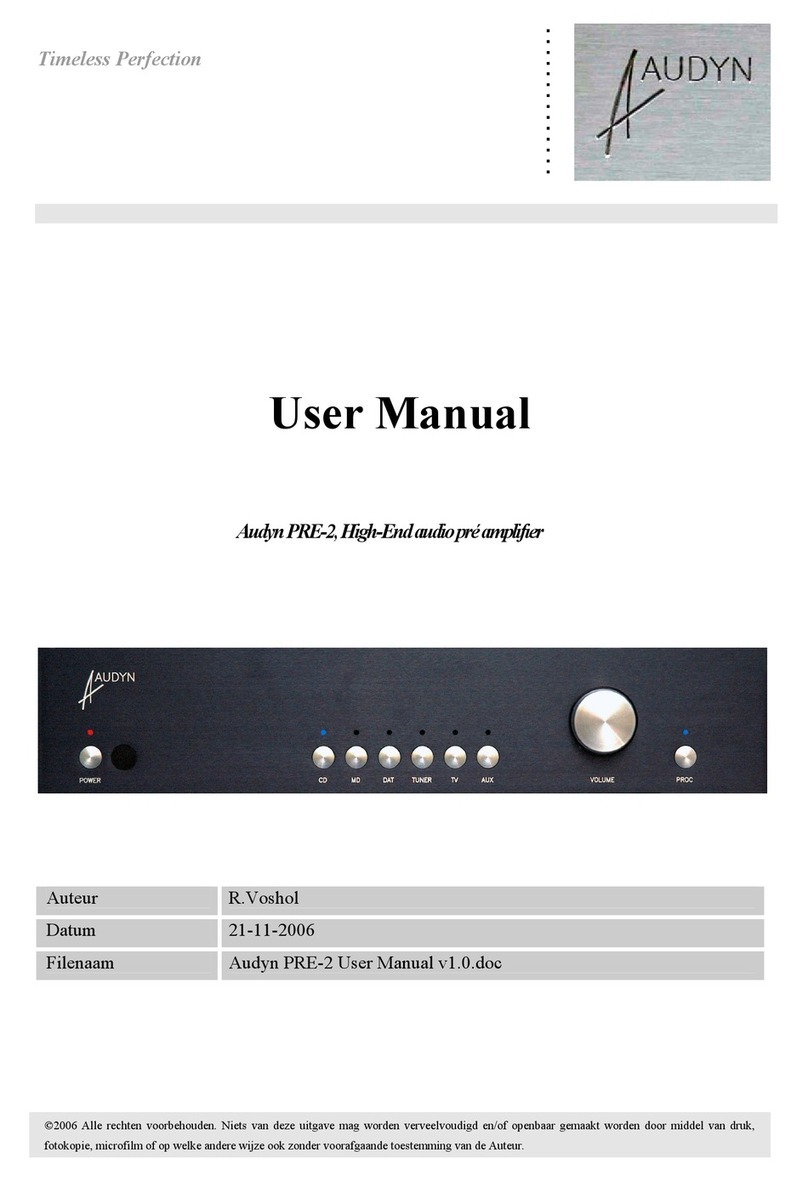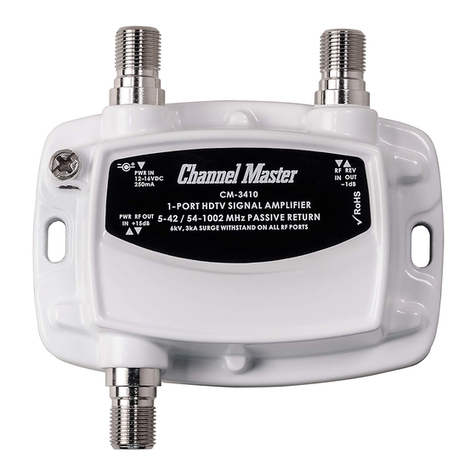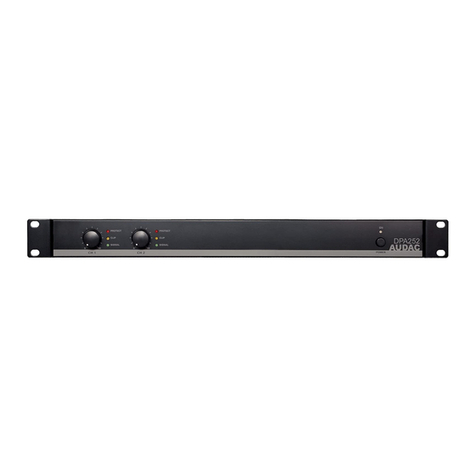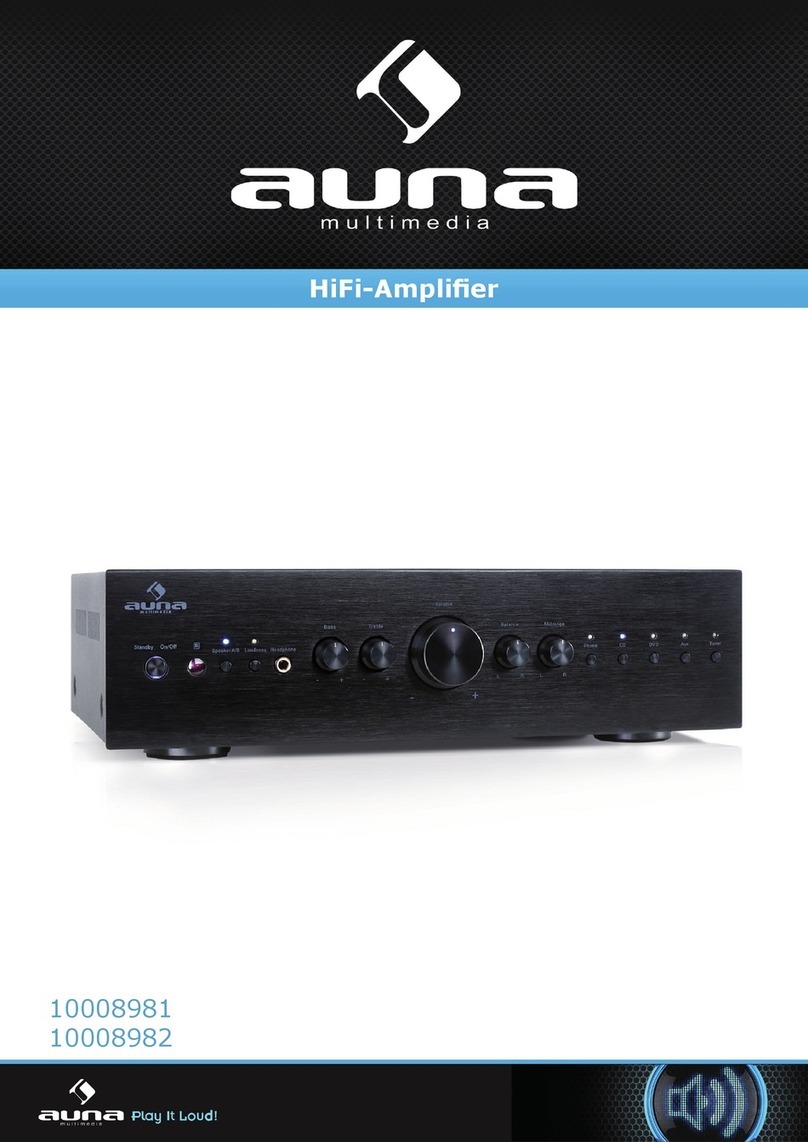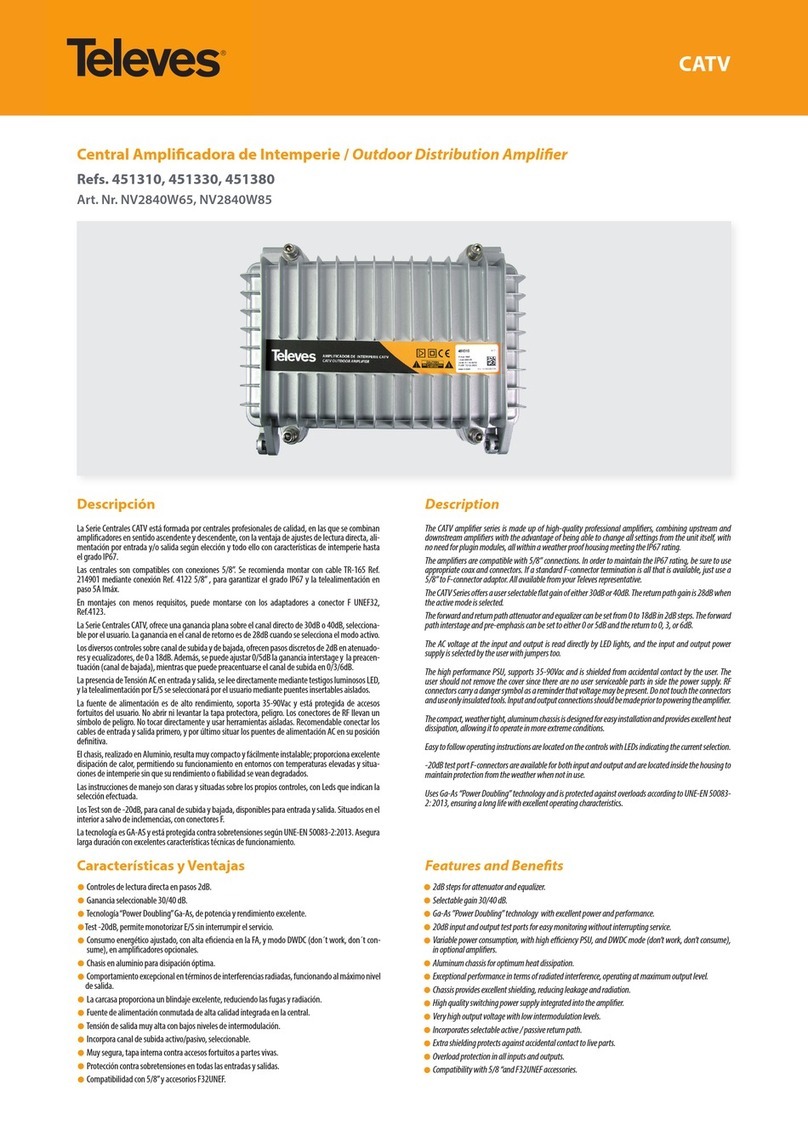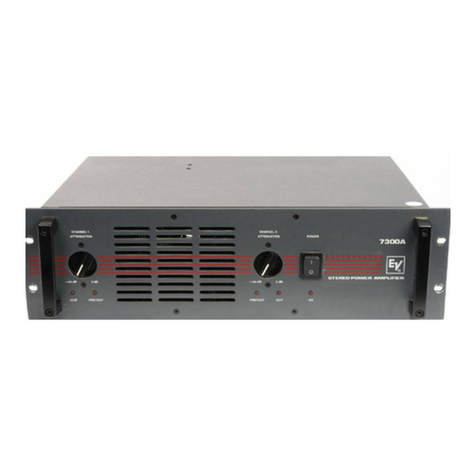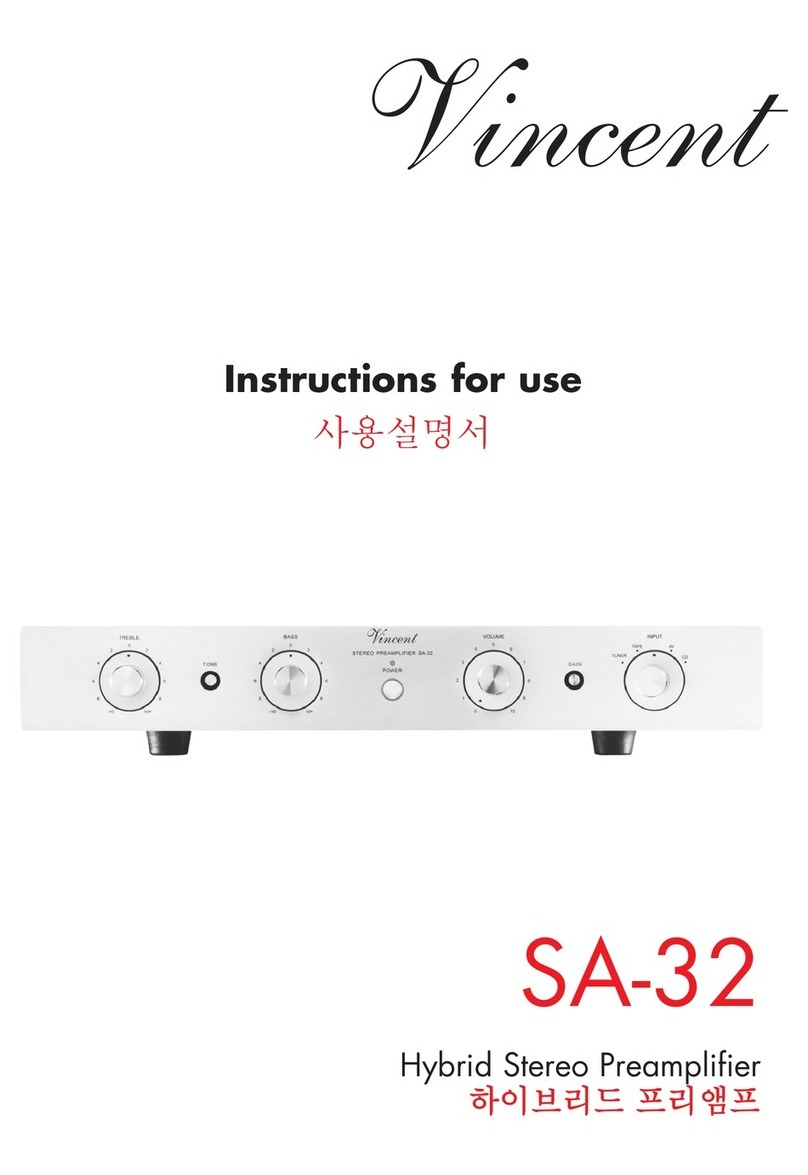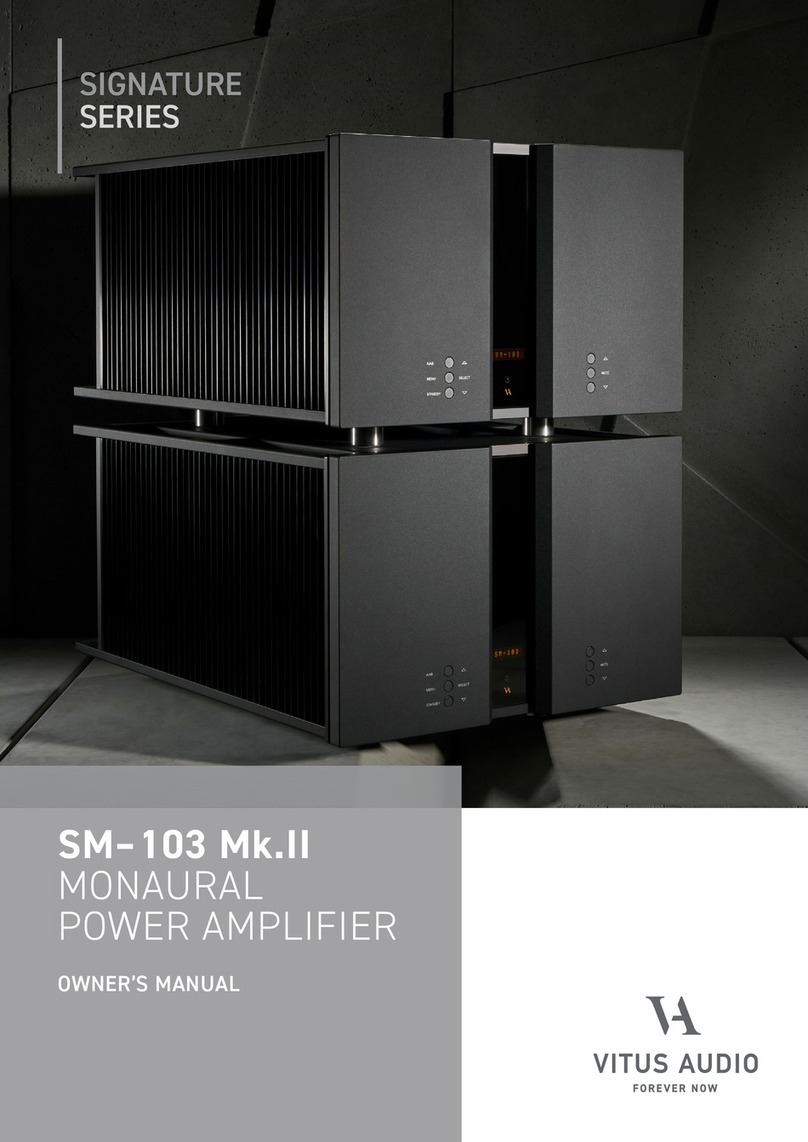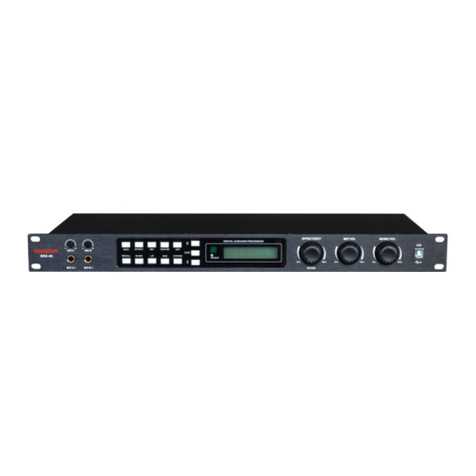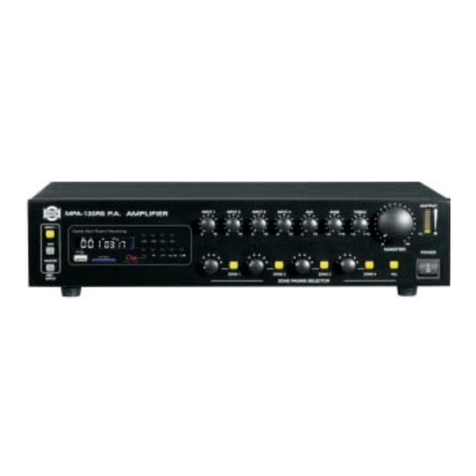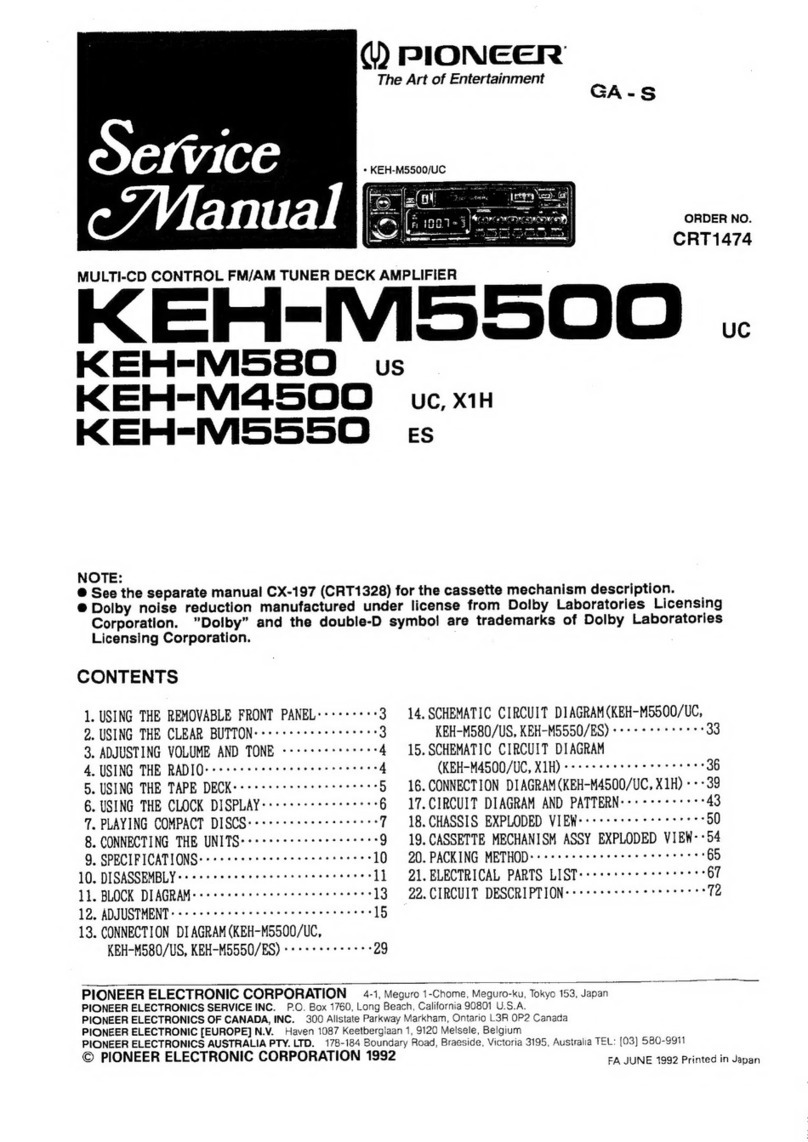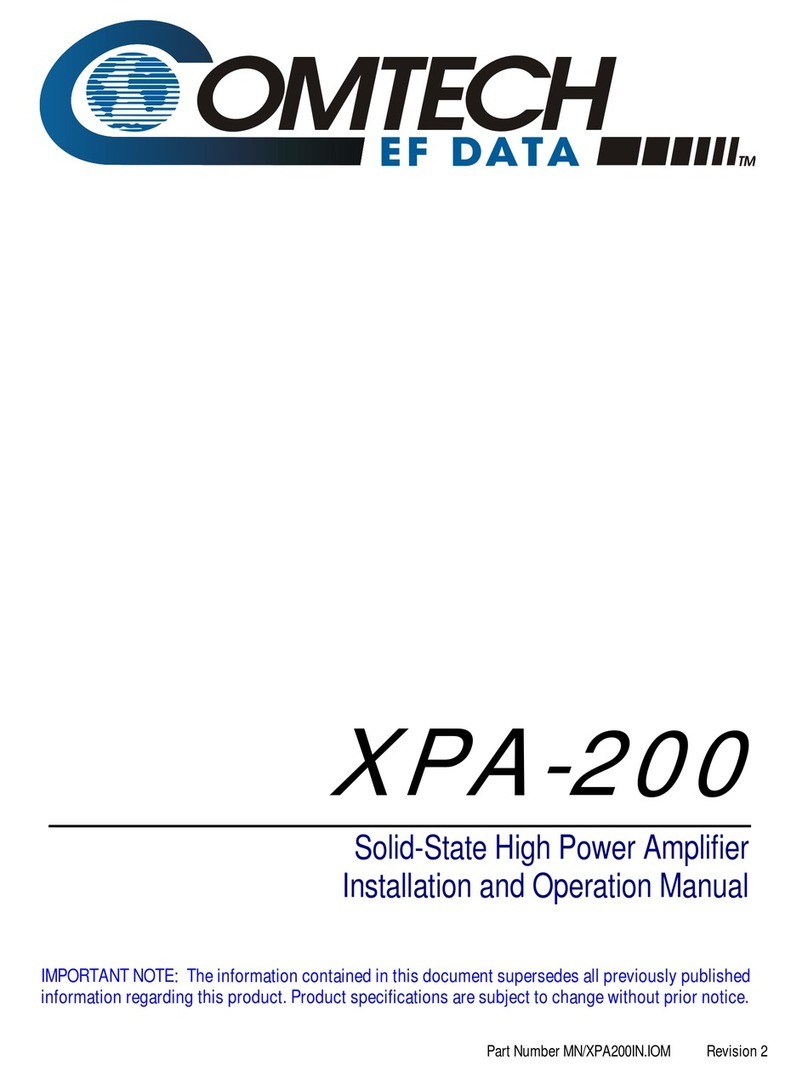Tektronix, Inc. 7A16 User manual

MR

I
N
STFR
U
CTI
O
N
MAN
UAL
Serial
Number
7A16
AMPLIFIER
Tektronix,
Inc
.
S
.W
.
Millikan
Way
"
P
.
O
.
Box 500
"
Beaverton,
Oregon
97005
"
Phone
644-0161
"
Cables
:
Tektronix
070-0980-00
1069

WARRANTY
All
Tektronix
instruments
are
warranted
against
defective
materials
and
workman-
ship
for
one
year
.
Tektronix
transformers,
manufactured
in
our
plant,
are
warranted
for
the
life
of
the
instrument
.
Any
questions
with
respect
to
the
war-
ranty
mentioned
above
should
be
taken
up
with
your
Tektronix
Field
Engineer
.
Tektronix
repair
and
replacement-part
service
is
geared
directly
to
the
field,
therefore
all
requests
for
repairs
and
re-
placement
parts
should
be
directed
to
the
Tektronix
Field
Office
or
representative
in
your area
.
This
procedure
will
assure
you
the
fastest
possible
service
.
Please
include
the
instrument
Type
and
Serial
or
Model
Number
with
all
requests
for
parts
or
service,
Specifications
and
price
change
privi-
leges reserved
.
Copyright
"'
1969
by
Tektronix,
Inc
.,
Beaverton,
Oregon
.
Printed
in
the
United
States
of
America
.
All
rights
reserved
.
Contents
of
this
publication
may
not
be
reproduced
in
any
form
without
permis-
sion
of
the
copyright
owner
.

SECTION
1
SPECIFICATION
Introduction
Electrical
Characteristics
Deflection
Factor
Gain
FrequencyResponse
Maximum
Input
Voltage
Input
Resistance
Input
Capacitance
Maximum
Input
Gate
Current
Noise
(Tangentially
Measured)
DC
Drift
Environmental
Characteristics
Altitude
Transportation
Physical Characteristics
Finish
Dimensions
Weight
SECTION
2
OPERATING
INSTRUCTIONS
General
Front
Panel
Controls
and
Connector
First
Time
Operation
Control
Setup Chart
General
Operating
Information
Basic
Applications
SECTION
3
CIRCUIT
DESCRIPTION
Introduction
Block
Diagram
Description
Detailed
Circuit
Description
Input
Coupling
Input
Attenuator
Input
Stage
First
Cascade
Stage
Second
CascadeStage
Output
Stage
Readout
Block
SECTION
4
MAINTENANCE
Preventive
Maintenance
Cleaning
Lubrication
Visual
Inspection
Transistor
Checks
Recalibration
Troubleshooting
Troubleshooting
Aids
Troubleshooting
Equipment
Troubleshooting
Techniques
Corrective
Maintenance
Obtaining
Replacement
Parts
Soldering
Techniques
Component
Replacement
TABLE
-OF
CONTENTS
Page
1-1
1-1
1-1
1-1
1-1
1-1
1-1
1-1
1-1
1-1
2-1
2-1
2-1
2-3
2-3
2-5
3-1
3-1
4-1
4-1
4-1
4-1
4-1
4-2
4-4
4-4
4-6
4-6
4-6
SECTION
6
ELECTRICAL
PARTS
LIST
Abbreviations
and
Symbols
Parts
Ordering
Information
Index
of
Electrical
Parts
List
3-2
3-2
3-2
3-2
3-3
SECTION
7
DIAGRAMS
AND
MECHANICAL
3-3
PARTS
ILLUSTRATIONS
3-3
Diagrams
Mechanical
Parts
Illustrations
SECTION
8
MECHANICAL
PARTS
LIST
Mechanical
Parts
List
Information
Index
of
Mechanical
Parts
Illustrations
Mechanical
Parts
List
Accessories
Change
Information
Type
7A16
Abbreviations
and
symbols
used
in this
manual
are
based
on
or
taken
directly
from
IEEE
Standard
260
"Standard
Symbols
for
Units",
MIL
STD-12B
and
other standards
of
the
electronics
industry
.
Change
information
if
any,
is
located
at
the
rear
of
this
manual
.
SECTION
5
PERFORMANCE
CHECK/
CALIBRATION
Introduction
5-1
Test
Equipment
Required
5-1
Short
Form
Procedure
5-2
Performance
Check/Calibration Procedure
Preliminary
Procedure
5-3
Preliminary
Control
Settings
5-4
Check
or
Adjust
DC
Balance
5-4
Variable
Balance
5-4
STEP
ATTENUATOR
Range
5-4
STEP
ATTENUATOR
Balance
5-4
Position
Centering 5-5
POSITIONRange
5-5
+UP
to
INVERT
Shift
5-5
GAIN
5-5
VARIABLERange
5-6
Trigger
DC
Level
5-6
Trigger
Gain
5-6
VOLTS/DIV
Deflection
Accuracy
5-6
Input
Compensation
5-7
Series
and
Shunt
Compensation 5-7
High
Frequency
Compensation
(5
mV)
5-8
High
Frequency
Compensation (10
mV)
5-8
High Frequency
Compensation (20
mV)
5-8
Step
Response
5-9
Upper
-3
dB
Point
5-9
Trigger
Step
Response
5-10
20
Megahertz
Bandwidth
Limiting
5-11
Noise
(Tangentially
Measured)
5-11

Fig
.
1-1
.
Type
7A16
Amplifier_

INTRODUCTION
The Type
7A16
vertical
amplifier
plug-in
unit
is
part
of
the
7000-series
oscilloscope
system
.
It is
a wide band
DC
coupled
amplifier
with
calibrated
deflection
factors
from
5
mV/Div
to
5V/Div
.
Internal
gain
and
compensation
circuits
are
auto-
matically
switched
to
correspond
with
the
setting
of
the
VOLTS/DIV
switch
.
A
polarity
switch
provides
an
inversion
of
the
signal within
the
amplifier
.
A
bandwidth
limit
switch
allows
low-frequency,
low-level
signals
to
be viewed
with
reduced
interference
from
signals
above
20 megahertz
.
The
upper bandwidth
limit
of
the
Type
7A16
is
mainly
determined
by
the
oscilloscope
in
which
it
is
used
.
For ex-
ample,
the
Type
7A16
used
with
the
Type
7504
oscilloscope
will
have
an upper bandwidth
limit
of
approximately
90
MHz,
and
when
plugged
into
a
Type
7704
oscilloscope
the
upper
bandwidth
limit will
be
approximately
150
MHz
.
Re-
fer
to
the
approperiate
oscilloscope
manual
for
complete
information
.
This
instrument
will
meet
the
electrical
characteristics
listed
in
Table
1-1
following
complete
calibration
as
given
in
Sec-
tion
5
.
The
performance
check procedure
given
in
Section
5
provides
a
convenient
method
to
check
instrument
per-
formance
without
making
internal
adjustments
.
The
folowing
electrical
characteristics
are
valid
over
the
stated
environmental
range
for
instruments
calibrated
at
an ambient
temperature
of
+20
°
C
to
+30
°
C,
and
after
a
five
minute
warmup
unless
otherwise
stated
.
The Type
7A16
should be
calibrated
every
1000
hours
or
every
6 months
if
used
infrequently
.
SECTION
1
SPECIFICATIONS
Change
information,
if
any,
affecting
rear
of
the
manual
.
TABLE
1-1
ELECTRICAL
this
section
will
be
found
at
the
TABLE
1-2
ENVIRONMENTAL
Type
7A16
20
Megahertz
Band-
DC
to
20 megahertz
within
3
width
metahertz
.
Risetime
15
nanoseconds
to
21
nanoseconds
.
Maximum
Input
Voltage
DC
(Direct)
Coupled
100
mV/Div
to
500
VDC
.
500
V,
DC
+
P-P
AC
at
5
V/Div
1
kHz
or
less
.
5
mV/Div
to
100
VDC
.
100
V,
DC
+
P-P
AC
at
50
mV/
Div
1
kHz
or
less
.
AC
(Capacitance
Cou- 500
V
.
pled
Input
DC
Volt-
age
Input
Resistance
1
me
ohm
within
2%
.
Input
Capacitance
15 picofarads
within
0
.5
picofarad
.
R
and
C
Product
Within
1
%
over
all
deflection
factor
settings
.
Maximum
Input
Gate
0
.5
nanoampere
or
less
at
0
°
C
Current
to
+35
°
C,
3
nanoamperes
or
less
at
+35
°
C
to
+50
°
C
.
Displayed
Noise
(Tan-
0
.1
division
or
less
at
5
mV
meas-
gentially
Measured)
ured
in
a
7700-Series
Oscilloscope
.
DC
Drift
Drift
With Time
(Ambi-
ent
Temperature
and
Line
Voltage
Constant)
Short
Term
250,u,V/minute
(P-P)
or
0
.05
divi-
,
sion
(whichever
is
greater)
after
1
hour
warmup
.
Long
Term
250
~V/hour
(P-P)
of
0
.05
division
(whichever
is
greater)
after
1
hour
warmu
w
.
Drift
With
Ambient
100ttV/
°
C
or
less
.
-
Temperature
(Line
Voltage
Constant)
Characteristic
Performance
Deflection
Factor
5
mV/Div
to
5
V/Div,
10
steps
in
Calibrated
Range
a
1-2-5
se
i
"
uence
.
Gain
Ratio
Accuracy
Within
2%
of
gain
adjusted
at
10
mV
Div
.
Uncalibrated
Continuously
variable
between
cal-
(Variable)
ibrated
deflection
factor
settings
.
Extends
uncalibrated
deflection
factor
to at
least
12
.5
V/Div
.
Gain
Permits
adjustment
of
deflection
factor
for
all
7000
series
oscillo-
scopes
.
Frequency
Response
;
System
Dependent
(8
With
Type 7704
WithType
7504
division
reference)
Oscilloscope
Oscilloscope
Upper
Bandwidth
DC
150
MHz
90
MHz
Coupled
Lower
Bandwidth
AC
10
Hertz
or
less
.
Coupled
With
P6053
Probe
1
Hertz
or
less
.
Characteristic
Performance
Temperature
O
.~ar
"
~
0
°
C
to
50°
C
Altitude
Non-operatin,
To
50,000
feet
and
-55
°
C
Transportation Qualified
under
National
Safe
Transit
Committee
test
procedure
1A,
Category
[I
.
TABLE
1-3
PHYSICAL
Item
Information
Finish
Front
Panel
is
anodized aluminum
.
Wei-
-
?-
:i
--_rA
m~w
W
pounds
.
Dimensions
Fits
plug-in
compartment
of
7000-
Series
Oscilloscopes
.

General
Installation
O?
SECTION
2
OPERATING
INSTRUCTIONS
Change
information,
if
any,
affecting
this
section
will
be
found
at
the
rear
of
the
manual
.
The
Type7A16
vertical
plug-in
unit
operates with a
Tek-
tronix
7000-series oscilloscope
and
a
7B-series
time
base
unit
to
form
a
complete
oscilloscope
system
.
To
effectively
use
the
Type
7A16,
the
operation
and
capabilities
of
the
instrument
should be
known
.
This
section
describes
the
op-
eration
of
the
front-panel
controls
and
connector,
gives
first
time operation
and
general
operating
information,
and
lists
some
measurement
techniques
using
the
amplifier
.
The
Type
7A16
is
designed
to
operate
in
a
vertical
plug-
in
compartment
of
Tektronix
7000-series
oscilloscopes
.
For
X-Y
operation,
the
plug-in
unit
may
also
be
installed
in
a
horizontal
plug-in
compartment
.
(Refer to
the
indicator
oscilloscope
instruction
manual
for
information
concerning
X-Y
operation
.)
To
install
the
Type
7A16
into
a
plug-in
compartment,
push
it
in until
it is
seated
into
the
front
panel
of
the indicator
unit
.
Pull
the
release
latch
to
disengage
the
plug-in
unit,
then continue
pulling
on
the
release
latch
to
remove
the
plug-in
from
the indicator
.
FRONT
PANEL
CONTROLS
AND
CONNECTOR
All
controls
required
for
operation
of
the
Type
7A16
are
located
on
the
front
panel
of
the
unit
.
A
brief
description
of
the
function
or
operation
of
the
front-panel controls
fol-
lows
.
More
detailed
information
is
given
under
General
Operating
Information
.
VOLTS/DIV
Selects
vertical
deflection
factor
from
5
mV/DIV
to
5
V/DIV
in
1-2-5
sequence
(VAR
control
must
be
in
the
calibrated
position
for
indicated
deflection
factor)
.
VARIABLE
Provides
variable
uncalibrated
deflection
(CAL
IN)
factors
to at
least
2
.5
times
the
setting
of
the
VOLTS/DIV
switch
.
Push
knob
in
and
release
to
activate
;
the
knob
moves
out-
ward
from
the
VOLTS/DIV
control
when
activated
.
POSITION
Controls
vertical
position
of
trace
.
IDENTIFY
Moves
trace
upward
about
0
.25
division
for
identification
.
(Also
replaces
readout
information
with
the
word
IDENTIFY
.)
Type
7A16
POLARITY
Provides
means
of
inverting the
display
.
-SUP
:
A
positive-going
voltage at
the
INPUT
produces
a
positive
de-
flection
on
the
CRT
.
BANDWIDTH
Provides
limiting
of
upper
bandwidth
.
FULL
:
Normal
operation with
full
band-
width
capabilities
.
20
MHz
:
Amplifier
bandwidth
limited
to
20
MHz
to
provide a
reduction
in
displayed high-frequency
noise
or
interference
.
AC-GND-DC
Selects
method
of
coupling
input
signal
to
Input
Amplifier
.
GAIN
Screwdriver adjustment
to
set
gain
of
the
amplifier
.
Gain
standardized
at
10
mV/
Div
.
STEP
ATTEN
Screwdriver adjustment
to
minimize
trace
BAL
shift
when
switching
VOLTS/DIV
control
.
INPUT
Signal
input
connector
.
Input
impedance
of
1
megohm
paralleled
by
15 picofarads
.
Similar
to
standard
BNC
connector,
but
with
additional
conductor
to
indicate
to
the
readout
circuit
the
attenuation
factor
of
the
probe
being used
.
General
Setup
Information
INVERT
:
A
positive-going
voltage
at
the
INPUT
produces
a negative de-
flection
on
the
CRT
.
FIRST-TIME
OPERATION
When
shipped
from
the
factory,
the
Type7A16
has
been
calibrated
to
meet
the
specifications
listed
in
Section
1
and
is
ready
to
be
used with
an
indicator
oscilloscope
.
The
following
steps
demonstrate
the
basic
operation of
the
controls
of
the
Type
7A16
.
It
is
recommended
that
this
procedure
be
followed
completely
for familiarization
with
the
instrument
.
Operation
of the
indicator
oscilloscope
and
time
base
unit
is
described
in
the
instruction
manuals
for
these
units
.
l
.
Insert
the
Type
7A16
into
a
vertical
plug-in
compart-
ment
of a
7000-series
indicator
oscilloscope
.
2
.
Insert
a
7B-series
time-base
unit into
a
horizontal
plug-
in
compartment
.
3
.
Set
the
controls
as
follows
:

Operating
Instructions-Type
7A16
Type
7A16
VOLTS/DIV
10
mV
VARIABLE
(CAL
IN)
Calibrated
POSITION
Midrange
POLARITY
-FUP
BANDWIDTH
FULL
AC-GND-DC
GND
Time Base
Time/Div
0
.5
ms
Variable
Time/Div
Calibrated
Slope
0/+
MODE
P-P
Auto
Coupling
AC
Source
Int
Position
Midrange
Indicator
Oscilloscope
Calibrator
40
mV
Square
Wave
Intensity
Counterclockwise
Focus
Midrange
Astigmatism
Midrange
Scale
Illum
As
desired
4
.
Connect
the
oscilloscope
to
a
power
source
which
meets
the
voltage
and
frequency
requirements
of
the
oscilloscope
power
supply
.
5
.
Turn
the
oscilloscope
power
on
and
allow
about
five
minutes
warmup
time
.
6
.
Advance
the
Intensity
and
set
the time
base
unit
trig-
gering
controls
to
obtain a
free-running
trace
on
the
CRT
.
Adjust
the
POSITION
controls
to
center
the
trace
vertically
.
7
.
Connect
the
Calibrator
output
to
the
INPUT
connector,
using
a
50-ohm
BNC
cable
.
Push the
Type
7A16
DC
input
coupling
button
.
(Adjust
horizontal
and
vertical
POSITION
controls
as necessary
.)
8
.
Set the
triggering
controls
for
a
stable
display
.
(Ad-
just
Focus
and
Astigmatism
controls
as
necessary
.)
9
.
Check
the
display
for
four
divisions
of
vertical
deflec-
tion
(see
Fig
.
2-1)
. If
necessary, adjust
the
front
panel
GAIN
control
for
four
divisions
of
deflection
.
10
.
Press
the
IDENTIFY
button
to
erase the
readout
infor-
mation
.
When
the
IDENTIFY
button
is
pressed
and
released,
the
display
moves
up
and
down
about
0
.25
division
.
This
movement
identifies
the
waveformwhen
more
than
one
dis-
play
is
on
the
CRT
.
11
.
Press
the
INVERT
button
to
display
the
opposite
po-
larity
of
the
square
wave
.
(When
observing
a symmetrical
waveform
such as the Calibrator
square
wave,
inverting
the
signal
makes
no
apparent
change
in
the display
.
This
is
because
the
time-base
unit
triggers
on
the
indicated
slope
of
the
displayed
waveform
.)
12
.
Switch
the
VOLTS/DIV
control
through
the
remaining
positions
of
the
switch,
setting
the
Calibrator
to
appropriate
output
amplitudes
.
The
STEP
ATTEN
BAL
control
may
be
adjusted
to
minimize
trace
shift
when
switching
the
VOLTS/
DIV
control
from 5
mV/DIV
to
20
mV/DIV
.
2-2
MEN
MEMMIMMEME
MOMMIMI
ONE
EMEMMINEEME
MEMO
=_M1ME_
Fig
.
2-1
.
40
mV
Calibrator
square
wave
.
This
completes
the
basic
operating
procedure
for the
Type
7A16
.
Instrument
operations not
explained
here,
or
opera-
tions
which
need
further
explanation,
are
discussed
under
General
Operating
Information
.
CONTROL
SETUP
CHART
Figure
2-2
shows
the
front
panel
of
the
Type
7A16
.
This
chart
can
be
reproduced
and
used as a
front-panel record
for
special
measurements,
applications
or
procedures,
or
it
may
be
used
as
a
training
aid for familiarization
with
this
instrument
.
GENERAL
OPERATING
INFORMATION
Signal
Connection
In
general,
probes
offer
the
most
convenient
means
of
connecting
signals
to
the
input
of
the
Type
7A16
.
The
Tek-
tronix
probes
are
shielded
to
prevent pickup
of
electrostatic
interference
.
A
IOX
attenuator
probe
offers
a high
input
impedance
and
allows
the
circuit
under
test
to
perform
very
close
to
normal
operating
conditions
.
However,
a
1OX
probe
also attentuates
the
input
signal
ten
times
.
To
obtain
maximum
bandwidth
when
using
probes,
observe
the
ground-
ing
considerations
given
in
the
probe manuals
.
The
probe-
to-connector
adapters
and
the
bayonet-ground
tip
provide
the
best
frequency
response
.
Remember
that
a
ground
strap
only a
few
inches
in
length
can
produce
several percent
of
ringing
when
operating at
the
higher
frequency
limit
of
this
system
(see
Fig
.
2-3)
.
In
high-frequency
applications
requiring
maximum
over-
all
bandwidth,
use
a
coaxial
cable
terminated
at
both ends
in
the
characteristic
impedance
of
the
cable
.
To
maintain
the high-frequency
characteristics
of
the
applied
signal,
use
high-quality,
low-loss
cable
.
Resistive
coaxial
attenuators
can
be
used
to
minimize
reflections
if
the
applied
signal
has
suitable
amplitude
.

DATA
TYPE
7A16
AMPLIFIER
SETUP
CHART
POSITION
INPUT
,MR
15pF
TEKTRONIX
O
7A16
AMPLIFIER
POLARITY
+UP
0
INVERT
a
BANDWIDTH
FU
LL
20MHz
VARIABLE
(CAL
IN)
VOLTS/DIV
STEP
ATTEN
BAL
Fig
.
2-2
.
Control setup
chart
.
Operating
Instructions
Type
7A16
2-
3

Operating
Instructions-Type
7A16
MEEM
ME
M
wo
OEM-M-0-mm
IM111011MMEM
ME
MEMOMM
ME
'ZZ'
Moro=
ENIMEMENEEN
MEMEMMEM
NERIMMENEME
EMEMEN
MEN
MMMM
MENEM
MMMEMMMMMM
MoMawd
""
ri
i
No
MENEEMME
Fig
.
2-3
.
Waveform
distortion
produced
with
incorrect
probe
ground
.
(A)
Eighteen-inch
ground
strap
between
generator
and
oscilloscope
.
(B)
Five-inch
ground
strap
.
High-level,
low-frequency
signals
can be
connected
di-
rectly
to
the
Type
7A16
INPUT
connector
with
short
unshielded
leads
.
This
coupling
method
works
best
for
signals
below
about
one
kilohertz
and
deflection
factors
above
one
volt/division
.
When
this
method
is
used,
establish
a
common
ground
between
the
Type
7A16
and
the
equipment
under
test
(common
ground
provided
by
line
cords
is
usually
in-
adequate)
.
Attempt
to
position
the
leads
away
from
any
source of
interference
to
avoid
errors
in
the
display
.
If
inter-
ference
is
excessive
with
unshielded
leads,
use
a
coaxial
cable
or
a
probe
.
Input
Coupling
The
AC-DC-GND
pushbutton
switch
allows a choice
of
input
coupling
.
The
type
of
display desired
determines
the
mode
of
input
coupling used
.
The
DC
position
can
be used
for
most
applications
.
However,
if
the
DC
component
of
the
signal
is
much
larger
than
the
AC
component,
the
AC
posi-
tion will
probably
provide
a
better
display
.
DC
coupling
2-4
should
be
used
to
display
AC
signals
below
about
10
hertz
as they
will
be
attenuated
in
the
AC
position
.
In
the
AC
position,
the
DC
component
of
the
signal
is
blocked
by
a capacitor
in
the
input
circuit
.
The
low-fre-
quency
response
in
the
AC
position
is
about
10
hertz
(-3dB
point)
.
Therefore,
some
low-frequency
distortion
can
be
expected near
this
frequency
limit
.
Distortion
will
also
ap-
pear
in
square
waves
which
have
low-frequency
components
.
The
GND
position
provides a
ground
reference
at
the
input
of
the
Type
7A16
.
The
signal
applied
to
the
INPUT
connector
is
internally
disconnected
but
not
grounded
.
The
input
circuit
is
held
at
ground
potential,
eliminating
the
need
to
externally
ground
the
input
to
establish
a
DC
ground
reference
.
The
GND
position
is
also
used
to
pre-charge
the
coupling
capacitor
to
the
average
voltage
level
of
the signal
applied
to
the
INPUT
connector
.
The
pre-charging
network
allows
the
input-coupling
capacitor
to
charge
to
the
DC
source
voltage
level
when
the
Input
Coupling
switch
is
set
to
GND
.
The
procedure
for
using
this
feature
is
as
follows
:
1
.
Before
connecting
the
signal
containing
a
DC
com-
ponent
to
the
Type7A16
INPUT
connector,
push
the
Input
Coupling
GND
button
.
Then
connect
the
signal
to
the
INPUT
connector
.
2
.
Allow about
one
second
for the
coupling
capacitor
to
charge
.
3
.
Push
the
Input
Coupling
AC
button
.
The
trace
(display)
will
return
on
the
screen
and
the
AC
component
of
the
sig-
nal
can
be
measured
in
the
normal
manner
.
Deflection
Factor
The
amount
of
vertical
deflection
produced
by
a
signal
is
determined
by
the
signal
amplitude,
the
attenuation
fac-
tor
of
the
probe
(if
used),
the
setting
of
the
VOLTS/DIV
switch
and
the
setting
of
the
VARIABLE
VOLTS/DIV
control
.
The
calibrated deflection
factors
indicated
by
the
VOLTS/
DIV
switch
apply
only
when
the
VARIABLE
control
is in
the
calibrated
(pushed
in)
position
.
The
VARIABLE
VOLTS/DIV
control
provides
uncalibrated
vertical
deflection
between
the
calibrated
settings of
the
VOLTS/DIV
switch
.
The
VARIABLE
control
extends
the
maxi-
mum
vertical
deflection
factor
of
the
Type
7A16
to at
least
12
.5
volts/division
(5V
position)
.
The
GAIN
control,
a
front-panel
screwdriver adjustment,
sets
the
gain
of
the
Type
7A16
Amplifier
.
The
vertical
de-
flection
of
the
unit
should be
checked
for
accuracy
prior
to
making
critical
measurements,
using
either
the indicator
unit
Calibrator
or a
Standard
Amplitude
Calibrator
(067-
0502-00)
.
If
adjustment
is
necessary,
the
GAIN
control
should
be
adjusted with
the
VOLTS/DIV
switch
in
the
10
mV
posi-
tion
.
Apply
a
40
millivolt
Calibrator
signal
to
the
INPUT
and
adjust
GAIN
for
four
divisions
of
display
.
Step
Attenuator
Balance
To
check
the
step
attenuator
balance, push
the
Input
Coup-
ling
GND
button
and
set
the
time-base
triggering controls
to
provide a
free-running
trace
.
Change
the
VOLTS/DIV
switch
from
20
mV
to
5
mV
.
If
the
trace
moves
vertically,
adjust
the
front-panel
STEP
ATTEN
BAL
adjustment
as
follows
(allow
O

(A)
mom
MEE
M
MM
M
Fig
.
2-4
.
(A)
CRT
display
showing
high-frequency
interference
when
attempting
to
view
low-level,
low-frequency
signal,
(B) resultant
display
when
20
MHz
pushbutton
is
pressed
.
at
least
ten
minutes
warmup
before
performing
this
adjust-
ment)
:
1 .
With
the
Input
Coupling
GND
button
pressed
and
the
VOLTS/DIV
switch
set
to
20
mV,
move
the
trace
to
the center
horizontal
line
of
the graticule
with
the
vertical
POSITION
control
.
2
.
Set the
VOLTS/DIV
switch
to
5
mV
and
adjust
the
STEP
ATTEN
BAL
adjustment
to return
the
trace
to
the center
hori-
zontal
line
.
3
.
Recheck
step
attenuator
balance
and
repeat
adjustment
until
no
trace
shift
occurs
as the
VOLTS/DIV
switch
is
changed
from
20
mV
to
5
mV
.
Signal
Polarity
The
POLARITY
switch
provides
a
means
of
inverting
the
display
.
With
the
+UP
button
pressed,
a
positive-going
Operating
Instructions-Type
7A16
voltage
at
the
INPUT
produces
a
positive
deflection
on
the
CRT
.
With
the
INVERT
button
pressed,
a
positive-going
voltage at
the
INPUT
produces
a negative
deflection
on
the
CRT
.
However,
when
observing
a
symmetrical
waveform,
such as
the
Calibrator
square
wave,
inverting
the
signal
makes
no
apparent
change
in
the
display
.
This
is
due
to
the
time-base
unit
triggering
on
the
indicated
slope
of
the
displayed
waveform
.
Bandwidth
Limiter
The bandwidth
switch
provides a
method
of
reducing
interference
from
unwanted
high-frequency
signals
when
viewing
low-frequency
signals
.
With
the
FULL
button
pressed,
the
full
bandwidth
capabilities
of
the amplifier
are
avail-
able
.
When
the
20
MHz
button
is
pressed,
the
upper
-3dB
bandwidth
point
of
the
amplifier
is
limited
to
about
20
megahertz
.
The
unwanted
high-frequency
signals
(such
as
television
broadcast
radiation
interference)
are
reduced
in
the
displayed
waveform
.
Fig
.
2-4
illustrates
the
use
of
this
feature
.
The
waveform
in
Fig
.
2-4A
is
the
display
produced
when
a
low-level,
low-frequency
signal
is
viewed
in
the
presence
of
a
strong
50-megahertz
radiation
(FULL
button
pressed)
.
Fig
.
2-4B
shows
the
resultant
CRT
display
when
the
high-frequency
interference
is
reduced
by
pressing
the
20
MHz
button
.
Display
Identification
When
the
Type
7A16
IDENTIFY
button
is
pressed,
the
CRT
display
is
deflected
upward
about
0
.25
division
for
identification
.
This
feature
is
particularly
useful
when
the
Type
7A16
is
used
with
an
indicator
unit
designed
for
use
with
more
than
one
vertical
amplifier
.
When
using
an
oscilloscope
system
equipped
with
the
readout
feature,
information
such
as
polarity,
deflection
factor,
etc
. i
s
displayed
on
the
CRT
.
When
the
Type
7A16
IDENTIFY
button
is
pressed,
the
readout
information
per-
taining
to
the
Type
7A16
is
replaced
by
the
word
IDENTIFY
.
BASIC
APPLICATIONS
The
following
information
describes
the
procedure
and
technique
for
making
basic
measurements
with
a
Type
7A16
Amplifier
.
These
applications
are
not
described
in
detail,
since
each
application
must
be
adapted
to
the
requirements
of
the
individual
measurements
.
Familiarity
with
the
Type
7A16
will
permit these basic
techniques
to
be
applied
to
a
wide
variety
of
uses
.
Peak-to-Peak
Voltage
Measurements-AC
To
make
a
peak-to-peak
voltage
measurement,
use the
following
procedure
:
1
.
Connect
the signal
to
the
INPUT
connector
.
2
.
Push
the
Input
Coupling
AC
button
.
3
.
Set
the
VOLTS/DIV
switch
to
display
about
five
divi-
sions
of
the
waveform
.
Make
sure
the
VARIABLE
VOLTS/DIV
control
is
in
the
calibrated
(pushed
in)
position
.
2-5

Operating
Instructions-Type
7A16
For
low-frequency
signals
below
about
10
hertz,
push
the
DC
button
.
4
.
Set the
triggering
controls
to
obtain
a
stable
display
.
Set
the
sweep
rate to
display
several
cycles
of
the
waveform
.
5
.
Turn
the
vertical
POSITION
control
so
the
lower
portion
of
the
waveform
coincides
with
one
of
the graticule
lines
below
the
center
horizontal
line,
and
the
top
of
the
wave-
form
is
within the
viewing
area
.
Move
the
display
with
the
horizontal
position
control,
so
one
of
the
upper peaks
lies
near
the
center
vertical
line
(see
Fig
.
2-5)
.
6
.
Measure
the
divisions
of
vertical
deflection
from
peak-
to-peak
.
This
technique
may
also
be
used
to
make
measure-
ments
betweentwo
points
on
the
waveform
rather
than
peak-to-peak
.
7
.
Multiply
the
distance
measured
in
step
6
by
the
VOLTS/
DIV
switch
setting
.
Also
include
the
attenuation
factor
of
the
probe,
if
any
.
Example
.
Assume
a
peak-to-peak
vertical
deflection
of
4
.6
divisions
using
a
1OX
attenuator
probe
and
a
VOLTS/
DIV
switch
setting
of
.5
V
.
Using
the
formula
:
Volts
vertical
VOLTS/DIV
probe
peak
to
peak
=
deflection
X
setting
X
attenuation
(divisions)
factor
Substituting
the
given values
:
NOTE
NOTE
Volts
peak
to
peak
=
4
.6
X
0
.5
X
10
The
peak-to-peak
voltage
is
23
volts
.
Fig
.
2-5
.
Measuring
peak-to-peak
voltage
of a
waveform
.
2-
6
Instantaneous
Voltage
Measurements-DC
To
measure
the
DC
level
at
a
given
point
on
a
waveform,
use
the
following
procedure
:
1
.
Connect
the
signal to
the
INPUT
connector
.
2
.
Set the
VOLTS/DIV
switch
to
display
about
five
divi-
sions
of
the
waveform
.
Make
sure
the
VARIABLE
VOLTS/DIV
control
is
in
the
calibrated
(pushed
in)
position
.
3
.
Push
the
Input
Coupling
GND
button
.
4
.
Set the
triggering
controls
to
obtain
a
free-running
trace
.
5
.
Position
the
trace
to
the
bottom
line
of
the
graticule
or
other
reference
line
. If
the
voltage
to
be measured
is
neg-
ative
with
respect
to
ground,
position
the
trace
to
the
top
line
of
the graticule
.
Do
not
move
the
vertical
POSITION
control
after
this
reference
line
has
been
established
.
NOTE
To
measure
a
voltage
level
with
respect
to
a
voltage other
than
ground,
make
the following
changes
in
step
5
:
Push
the Input
Coupling
DC
button
and
apply
the
reference
voltage
to
the
INPUT
connector
.
Then
position
the trace to
the
reference
line
.
6
.
Push
the
Input
Coupling
DC
button
.
The
ground
ref-
erence
line
can
be
checked
at
any
time
by
pushing
the
GND
button
.
7
.
Set the
triggering
controls
to
obtain
a
stable
display
.
Set the
sweep
rate
to
display
several
cycles
of
the signal
.
8
.
Measure
the
distance
in
divisions
between
the
reference
line
and
the
point
on
the
waveform
at
which
the
DC
level
is
to
be
measured
.
For
example,
in
Fig
.
2-6 the
measurement
is
made
between
the
reference
line
and
point
A
.
9
.
Establish
the
polarity
of the
signal
.
If
the
waveform
is
above
the
reference
line,
the voltage
is
positive
;
below
the
line,
negative
.
10
.
Multiply
the
distance
measured
in
step
8 by the
VOLTS/DIV
switch
setting
.
Include
the
attenuation
factor
of
the probe,
if
any
.
Example
.
Assume
that
the
vertical
distance
measured
is
4
.6
divisions,
the
waveform
is
above
the
reference
line,
using
a
1OX
attenuator
probe
and
a
VOLTS/DIV
switch
setting
of
2
V
.
Using
the
formula
:
Instantaneous
Voltage
=
vertical
VOLTS/DIV
probe
distance
X
polarity
X
setting
X
attenuation
(divisions)
factor
Substituting
the
given
values
:
Instantaneous
voltage
=
4
.6
X
+1
X
2
V
X
10
The
instantaneous
voltage
is
+92
volts
.

EMEMENINEME
Refere~lme
Fig
.
2-6
.
Measuring
instantaneous
DC
voltage
with
respect
to
a
reference
voltage
.
Voltage
Comparison
Measurements
In
some
applications,
it
may
be necessary
to
establish
a
set
of
deflection
factors
other
than
those
indicated
by
the
VOLTS/DIV
switch
.
This
is
useful
for
comparing
signals
to
a
reference
voltage
amplitude
.
To
establish
a new
set
of
deflection factors
based
upon
a
specific
reference
ampli-
tude,
proceed
as
follows
:
l .
Apply
the
reference
signal
of
known
amplitude
to
the
INPUT
connector
.
Using
the
VOLTS/DIV
switch
and
the
VARIABLE
control,
adjust
the
display
for
an
exact
number
of
divisions
.
Do
not
move
the
VARIABLE
VOLTS/DIV
con-
trol
after
obtaining
the
desired deflection
.
2
.
Divide
the
amplitude
of
the
reference
signal
(volts)
by
the product
of
the
deflection
in
divisions
(established
in
step
1)
and
the
VOLTS/DIV
switch
setting
.
This
is
Deflection
Conversion
Factor
.
Deflection
Conversion
=
Factor
reference
signal
amplitude
(volts)
deflection
(divisions)
X
VOLTS/DIV
setting
Operating
Instructions
Type
7A16
3
.
To
determine
the
peak-to-peak
amplitude
of
a
signal
compared
to
a
reference,
disconnect
the
reference
and
apply
the
signal to
the
INPUT
connector
.
4
.
Set the
VOLTS/DIV
switch
to
a
setting
that
provides
sufficient
deflection
to
make
the
measurement
.
Do
not
re-
adjust
the
VARIABLE
VOLTS/DIV
control
.
5
.
To
establish
an
Adjusted
Deflection
Factor
at
any
setting
of
the
VOLTS/DIV
switch,
multiply
the
VOLTS/DIV
switch
setting
by
the
Deflection
Conversion
Factor
established
in
step
2
.
Adjusted
VOLTS/DIV
Deflection
Deflection
=
setting
X
Conversion
Factor
Factor
This
Adjusted
Deflection Factor
is
correct
only
if
the
VAR-
IABLE
VOLT/DIV
control
is
not
moved
from
the
position
set
in
step
l
.
6
.
Measure
the
vertical
deflection
in
divisions
and
de-
termine
the
amplitude
by
the
following
formula
:
Deflection
Conversion
=
Factor
Signal
Adjusted
deflection
Amplitude
-
Deflection
X
Factor
(divisions)
Example
.
Assume
a
reference
signal
amplitude
of
30
volts,
a
VOLTS/DIV
setting
of 5
and
a
deflection
of
four
divisions
.
Substituting
these values
in
the
Deflection
Con-
version
Factor
formula
(step
2)
.
30
V
4X5V
_
1
.5
Then, with a
VOLTS/DIV
switch
setting
of
2,
the
Adjusted
Deflection Factor
(step
5)
is
:
Adjusted
Deflection
=
2
V
X
1
.5
=
3
volts/division
Factor
To
determine
the
peak-to-peak amplitude
of
an applied
signal
which
produces
a
vertical
deflection
of
five
divisions,
use the
Signal
Amplitude
formula
(step
6)
:
Signal
=
3
V
X
5
=
15
volts
Amplitude

Introduction
This
section
of
the
manual
contains
a
description
of
the
cir-
cuitry
used
in
the
Type
7A16
amplifier
.
The
description
begins
with
a
discussion
of
the
instrument
using
the
block
diagrams
shown
in
the
Diagrams
section
.
Then each
circuit
is
described
in
detail
using
the
block
diagram
to
show
in-
terconnections
between
the
circuits
and
the relationship
of
the
frontpanel
controls
to
the
individual
stages
.
Complete
schematics of
each
circuit
are given
in
the
Diagrams
section
.
Refer
to
these
diagrams
throughout
the
following
circuit
description
for
electrical
values
and
rela-
tionship
.
The
following
discussion
is
provided
to
aid
in
understand-
ing the
overall
concept
of
the
Type
7A16
before the
indi-
vidual
circuits
are
discussed
in
detail
.
Each
block
on
the
Block
Diagram,
located
in
the
Diagrams
section,
represents
an
individual
circuit
within the
instrument
.
The number
on
BLOCK
DIAGRAM
DESCRIPTION
SECTION
3
CIRCUIT
DESCRIPTION
Change
information,
if
any,
affecting
this
section
will
be
found
at
the
rear
of
this
manual
.
Fig
.
3-
1
.
Signal paths
through
input
COUPLING
switch
.
Type
7A16
each
block
refers
to
the
diagram
on
which
the
complete
circuit
is
found
.
The
signal
to
be
displayed
on
the
CRT
is
applied
to
the
INPUT
connector,
through
the
input
coupling
circuit
to
the
VOLTS/DIV
switch
.
The
VOLTS/DIV
switch
provides
the
appropriate
input attenuation
and
applies
the
signal to
the
first
stage
of
the
Input
Amplifier
.
The
signal
is
coupled
through
two
emitter followers,
Q40-Q50,
to
the
First
Cas-
code
stage,
which
operates
as a
phase-splitter
.
The
First
Cascade
stage,
Q60A-Q70-Q60B-Q90,
contains variable
gain
circuits
and
bandwidth
limiting
circuits
.
The
Second
Cascade
Stage,
Q100A-Q120A-Q100B-Q120B,
provides
gain-switching,
signal
polarity
inversion,
and
ver-
tical
positioning
.
The
gain-switching
relays
in
the
two
cas-
code
stages
are
operated
by
the
VOLTS/DIV
switch
which,
with
the
input
attenuators,
sets
the
overall
gain
of
the
am-
plifier
.
Additional
amplification
is
provided
by
the
Output
Amplifier,
Q125-Q140-Q165-Q180
.
The
Trigger
Pickoff
cir-
cuit,
Q130-Q135-Q170-Q175,
takes
the signal
from
the
emit-
ters
of
Q125-Q165
and
amplifies
it
to
provide
+
and
-
trigger signals
for the
time
base
unit
.

Circuit
Description-Type
7A16
In
addition
to
the functions
of
the
amplifier
just
explained,
the
Type
7A16
also
provides
readout
logic
for
the indicator
oscilloscope,
Logic
identifying
the
Polarity
and
the
deflection
factor,
whether
calibrated
or
uncalibrated
is
supplied
.
When
the
IDENTIFY
button
is
pressed,
the
readout
is
replaced with
DETAILED
CIRCUIT
DESCRIPTION
Input
Coupling
Input
signals
applied
to
the
INPUT
connector
can
be
AC-
coupled,
DC-coupled,
or internally
disconnected
.
The
input
coupling
relay,
K5,
a dual pole
alternate
throw
relay,
is
operated
by
S3,
a
three-position
pushbutton
switch
.
Only
one
side of
the
DPAT
relay
operates
at
a time
.
When
the
AC
button
is
pressed,
K5A
is
actuated
providing
a
signal
path
from
the
INPUT
connector through
C3-K5A-K5B-C2-R2
(see
Fig
.
3-1A)
.
In this
position,
C3
prevents
the
DC
com-
ponent
of
the
signal
from
passing
to
the
amplifier
.
When
the
DC
button
is
pressed,
K5B
is
actuated,
providing a
sig-
nal
path
directly
through
K5B
to
Rl
(see
Fig
.
3-1C)
.
When
the
GND
button
is
pressed,
the
input
signal
is
AC-coupled
through
C3
and
R3
to
ground
.
The
input
circuit
is
grounded
to
provide a zero
volts
reference
level
(see
Fig
.
3-113)
.
Re-
sistor
R3 allows
C3
to
be
precharged
in
the
GND
position
so
the
trace
remains
on
screen
when
the
AC
button
is
pressed
with
a
high
DC
level
applied
.
Input
Attenuator
The
effective
overall deflection
factor
of
the
Type
7A16
is
determined
by
the
VOLTS/DIV
switch attenuators
and
the
gain-switching
relays,
K105-K110-K155-K160
.
The
5
mV,
10
mV,
and
20
mV
switch
positions
employ
1
X
attenuators
.
In all
positions
of
the
VOLTS/DIV
switch
above
20
mV,
the
basic
deflection
factor
of
the
vertical
deflection
system
is
20
millivolts
per
division of
deflection
.
To
increase
this
basic
deflection
factor to
the
values
indicated
on
the
front
panel,
precision
attenuators
are switched
into
the
input
circuit
.
The
positions
of
the
VOLTS/DIV
switch
and
the
corresponding
attenuators
are as
follows
:
The
Input
Attenuators,
with
R14-C14-Rl7-R18-Cl8
form
frequency-compensated
voltage
dividers
.
For
DC
and
low-
frequency
signals,
they
are
primarily
resistance
dividers
and
the
voltage
attenuation
is
determined
by
the
resistance
ratio
in
the
circuit
.
The
reactance
of
the
capacitors
in
the
circuit
is
so high at
low
frequencies
that
their
effect
is
negligible
.
However,
at
higher
frequencies,
the
reactance
of
the
capac-
itors
decreases
and
the
attenuator
becomes
primarily
a
capacitance
voltage
divider
.
In
addition
to
providing
constant
attenuation
at
all
fre-
quencies
within
the
bandwidth
of
the
system,
the
Input
Attenuators are
designed
to
maintain
the
same
input
RC
3-2
characteristics
(one
megohm
X15
pF) for
each
setling
of
the
VOLTS/DIV
switch
.
The
attenuators
contain
adjustable
shunt
capacitors
to
provide
input
capacitance
.
Input
Stage
The
signal
from
the
Input
Attenuator
is
connected
to
the
Input
Stage
through
the
network
Rl4-Cl4-Rl7-Rl8-Cl8
.
These
resistors
are
part
of
the
attenuation
network
at
all
VOLTS/
DIV
switch
positions
.
Variable
capacitor
C18
adjusts
the
basic input
time
constant
for
a
nominal
value
of
one
meg-
ohm
X
15
picofarads
.
R14-C14
isolate
the
input
from
the
gate
of
the
input
field-effect
transistor,
Q20
.
Resistor
R14
also
limits
the
gate
current
of
Q20
.
FET
Q20B
is
a
constant
current
source
for
the
source
fol-
lower,
Q20A
.
The
DC
Bal
adjustment,
R34,
varies the
gate
level
of
Q20B
to
provide a zero
volt
level
at
the
base
of
Q60A
with
no
signal
applied
.
Low-frequency
by-pass
ca-
pacitors
C34
and
C36,
with
L34,
filter
noise
from
the
gate
of
Q20B
.
L20-C20
and
L30-C30
are
decoupling
networks
.
Damping
for
Q20A
is
provided
by
R23
.
The
source
of
Q20A
is
isolated
from
the
base
of
Q40
by
R28-C28
.
Resistor
R28
sets
the
bias
of
Q20A,
preventing
the
gate
from
going
more
positive
than
the
source
.
Damping
for
Q20B
is
provided
by
R38
.
The
bias
for
Q20B
is
set
by R30
.
Diode
CR29
clamps
the
gate
of
Q20A
at
about
-12
volts,
protecting
the
FET
from
large
negative voltage
swings
.
Two
emitter followers,
Q40
and
Q50
couple
the
input
sig-
nal
through
R52-C52
to
the
First
Cascade
Stage
.
Capacitors
C45
and
C52
are
adjustable
for
high
frequency
peaking
.
In
the
collector
of
each
of
the
emitter
followers
is
a
damping
adjustment
.
Maximum
damping
for
Q40
is
achieved
when
R40
is
adjusted
away
from
the
collector
of
Q40
.
Maximum
damping
for
Q50
is
achieved
when
R55
is
adjusted
away
from
the
collector
of
Q50
.
These
two
damping
adjustments
are
set for
a
compromise
between
maximum
risetime
and
minimum
ringing
.
Capacitors
C23 and C56
assure
that
no
feedback
signals
are
seen
by
the
input
FETs
.
First
Cascode
Stage
The
first
cascade
stage
is
a
paraphase
amplifier
.
With
R34
adjusted
for
zero
volts
at
the
base
of
Q60A,
the
quies-
cent
current
through
both
sides
of
the
paraphase
amplifier
is
approximately
10
milliamperes
.
The
input
signal drives
the
base
of
Q60A,
and
the
base
of
Q60B
is
grounded
through
R82
.
A
positive signal at
the
base
of
Q60A
increases
the
current
through
R60-Q60A-R68-R71-Q70-R100
and
reduces
the
current
through
R80-Q60B-R88-R90-Q90-Rl50,
producing
push-pull
signals
at
the
bases
of
Q100A
and
Q100B
.
Resistor
R68,
paralleled
by
C68-1_68,
and
R88,
paralleled
by
C88-1_88,
provide
thermal
balance
for
the
stage
.
Resistors
R70,
R71
and R90
provide
damping
.
The
divider
R73-R74
sets
the
base
voltage
of
Q70
and
Q90
at
approximately
6
.7
V
.
The
common-emitter
circuit
contains
two
high-frequency
peaking
adjustments,
C61
and
R61
.
The
voltage gain of
this
stage,
from
single-ended
to
push-
pull,
is
approximately
1
.6
and
is
set
by
the
ratio
of
R100
or
R150
to
R60 and R80
.
With
K65
as
shown
(VARIABLE
pushed
in),
the
exact
gain
of
the amplifier
is
set
by
R66
(VOLTS/DIV
switch
set
to
10 mV),
which
adjusts
the
amount
of
shunt
current
through
R64-R66-R84
.
Relay
K65,
actuated
in
the
uncalibrated
position,
switches
in
the
R65-R85-RB6
O
i
5
mV 1X
.2V
lox
10mv
1X
.5V
25X
20
m
V
1
X
.1
V
50X
50
mV
2
.5X
2
V
l00X
.1
V
5
X
5
V
250
X
the
word
IDENTIFY
.
At
the
same
time,
the collector
of
Q120B
is
grounded
through
R200,
shunting
some
of
the
collector
current
which
moves
the
trace
upward
approxi-
mately
0
.25
division
.

network
and
switches
out
the
R64-R66-R84
network
.
The
VARIABLE
control
(R86) affects
the
gain
of
the
amplifier
by
a
greater
degree
than R66,
due
to
the
comparatively
small
values
of
R65 and
R85
.
With
R86
set
to
minimum
resistance,
the
gain
of
the
amplifier
is
reduced
by a
factor
of at
least
2
.5
.
TheVar
Gain
Bal
control,
R89,
is
adjusted
for
no
trace
shift
when
K65
is
switched
.
With
the
BANDWIDTH
switch
FULL
button
pressed,
the
output
of
the
first
cascode
stage
is
connected
directly
through
K75
to
the
second
cascode
stage
.
With
the
20
MHz
button
pressed,
the
bandwidth
limiting
circuit,
C77-C97-L76-L96-L97,
is
switched
in
by
K75
.
This
sets
the
upper
frequency
limit
of
the
amplifier
to
approximately
20
MHz
.
Second
Cascode
Stage
The second
cascade
stage,
formed
by
QIOOA-Q120A-
Q100B-Q120B,
contains
gain
switching,
signal inversion,
and
vertical
positioning
circuits
.
The
gain of
this
stage
in
the
5
mV
position of
the
VOLTS/DIV
switch
is
set
by
the
ratio
of
8123
or
R163
to
R102
or
R151
.
With
the
POSITION
con-
trol
and
R117
set
to
midrange,
the
quiescent
current
through
Q100A
and
Q100B
is
approximately
15
milliamperes,
set
by
R104-R106-R156
.
The
quiescent
current
through
Q120A
and
Q120B
is
approximately
10
milliamperes,
set
by
R118-
R166
.
In
the
10
mV
position,
Kl
10
and
K160
switch
in
shunt
resistor
R161,
reducing the gain by a
factor
of
two
.
In
the
20
mV
position,
K105
and
K155
switch
in
shunt
resistor
R159
and
series
resistors
R108
and
R158,
reducing
the
gain
by
an
additional
factor
of
two
.
The
deflection
factor
at
the
out-
put
of
this
stage
is
15
mV/Div
per
side
.
The
emitter
circuit
of
Q100A-Q100B
contains
high-fre-
quency
peaking
adjustments
C102-R103-C103
.
Compensation
in
the
10
mV
position
is
provided
by
C111-R111
.
Additional
compensation
in
the
20
mV
position
is
provided
by
C109-
R109
.
Thermal
compensation
networks
for
Q100A
and
Q100B
are
formed by
R105-C105
and
R155-C155
.
Resistors
R106
and
R156
set
the
voltage
drop
across
the
gain-setting
di-
viders
to
zero
volts
.
The
Step
Atten
Bal
control,
R153,
is
adjusted
for
no
trace
shift
when
switching
K105
and
K155
or
K110
and
K160
.
Thermal
compensation
networks
for
Ql20A
and
Q1
20B
are
formed
by
C124-R124
and
C164-R164
.
The
polarity
inversion
circuit
consists
of
a
DPDT
relay,
K115,
and
a
front
panel
push-button
POLARITY
switch
.
With
the
+UP
button
pressed,
the
relay
is
as
shown
in
the
schemat-
ic
.
With
the
INVERT
button
pressed,
Kl15
is
actuated,
in-
verting
the signal
outputs
and
the
trigger
outputs
.
The
vertical
POSITION
control,
R115,
applies
DC
voltages
of
opposite
polarity
to
the
two
sides
of
the
amplifier
through
R114
and
R160
.
This offset
voltage
is
DC-coupled
to
the
output
moving
the
trace
upward
or
downward
on
the
CRT
.
With
the
vertical
POSITION
control
set
to
midrange,
the
position
centering
network, R117-R118-R168,
applies
a
posi-
tive
voltage
to
one
side of
the
amplifier,
centering
the
trace
vertically
on
the
CRT
.
Output
Stage
The
output stage
consists of
the
emitter-feedback
and
shunt-feedback
amplifiers,
Q125-Q165
and
Q140-Q180,
and
the
trigger
pick-off
amplifier
Q130-Q135-Q170-Ql75
.
The
gain
of
the
output
amplifier
is
approximately
five,
set
by
Readout
Block
Circuit
Description-Type
7A16
the
ratio
of
R142-R182
to
R128-R168
.
Thermistor
(RT128)
and
Varactors
(CR128-CR168)
provide
proper
compensation
for
transient
response
variations
with
temperature
.
Thermal
compensation
for
Q125
and
Q165
is
provided
by
R125-C125
and
R165-C165
.
Resistor
R129
provides the
DC
current
source
for
Q125
and
Q165
.
Decoupling
for
the
output
amplifier
is
provided
by L140
and
C140
.
The
-15
volt
supply
is
decou-
pled
in
the
common-emitter
circuit
of
Q140-Q180
by
L143
and
C143
.
R141-R181-R143
provide
approximately
18
milli-
amperes
DC
current
for
each
output
transistor
.
The
output
signals
are
reverse
terminated
by
C145-R145
and
C185-R185
.
These
networks,
with
the
50-ohm
terminations
in
the indicator
oscilloscope,
produce
an
output
deflection
factor
of 25
milli-
volts/division
per
side
.
The
trigger
pickoff
amplifier
takes
the
output
signal
from
the
emitters
of
Q125
and
Q165
and
amplifies
it
to
a
level
near
that
of
the
output
amplifier
.
Resistor
R131
sets
the
DC
current
for
Q130
and
Q170
through
R130
and
R170
respec-
tively
.
Capacitor
C130
provides high-frequency
peaking
.
Thermal
compensation
for
Q130
and
Q170
is
provided
by
C133-R133
and
C173-R173
.
Divider
R172-R174-R137-R177
provides
approximately
15
milliamperes
each
for
Q135-Q175
.
The
output
signal
from
the
trigger pickoff
amplifier
is
reverse
terminated by
C138-R138
and
C178-R178
.
The
readout
block
consists of
switching
resistors
and
a
probe
sensing
device
.
The
switching
resistors,
selected
by
the
setting
of
the
Readout
Switch
(part
of
the
VOLTS/DIV
switch),
are
used
to signal
the Indicator
Oscilloscope
the
setting
of
the
VOLTS/DIV
switch
.
Refer
to
Schematic
Diagram
4
(Section
7),
Switching
and
I :
;terconnecting
Plug,
to find
the
resistors
associated
with
a
particular
setting
of
the
VOLTS/DIV
switch
.
The
number
1,
2,
or 5
is
selected
by
R207-R208-R209
.
R207
selects
the
numeral
1,
R207-R208
selects
the
numeral
2,
and
R207-R209
.
selects
the
numeral
5
.
R226-R228-R234
and
the
output
of
the
probe
sensing
device (Q200)
selects
the
decimal
point
(number
of
zeroes)
.
R224-R225,
when
switched
in,
gives
the
Volts sub-unit
m
(milli)
.
R205-R206
selects
the
symbol
V
(volts)
.
R218-R220
selects
the
symbol
>
when
the
VARIABLE
VOLTS/
DIV
knob
is
in
the
uncalibrated
position
.
R219-R222
selects
the
symbol
+
when
the
INVERT
pushbutton
is
pressed
in
.
The
probe
connected
to
the
INPUT
connector
forms a
voltage
divider
with
R202
to
the
-15
volt
supply
.
The
amount
of
probe
resistance
will
determine
the
bias
applied
to
the
base
of
Q200
.
With
a
1
X
probe
connected,
Q200
is
biased
off
by
the
-15
volt
supply,
and
the
deflection
factor
(in
the
readout
display)
is
determined
by
the
setting
of
the
Readout
Switch
(part
of
the
VOLTS/DIV
switch)
.
With
a
IOX
probe
connected
to
the
INPUT
connector,
the
bias
applied
to
the
base
of
Q200
will
allow
1001(A
of
collector
current
to
flow
.
When
the
clock
pulse
interrogates
interface
connector
B33,
this
current
is
added
to
the
current
corresponding
to
the
setting
of
the
Readout
Switch
to
in-
crease
the
deflection
factor
(in
the
displayed
readout)
by 10
.
The
Indicator
Oscilloscope displayed readout
will
give
the
correct
deflection
factor
from
the
probe
tip (using
the
3-3

Circuit
Description-Type
7A16
recommended
attenuator
probes)
whereas
the
VOLTS/DIV
knob on
the
Plug-In
will
display
only
the
Plug-In
deflection
factor
.
The
trace
IDENTIFY
button,
when
pressed,
does
two
things
:
l
.
It
causes the
trace,
representing
the
output
of
the
Type
7A16,
to
move
upward
a
small
amount
by
inserting
R200
from
the
collector
of
Q120B
to
ground
.
This
shunts
a
small
amount
of
the
collector
current
causing
the
trace
to
move
.
2
.
It
also
grounds
the
base
of
Q200
.
This
causes
Q200
to turn
on hard
erasing
the
displayed
readout
and
causing
the
word
IDENTIFY
to
appear
.
These
two
actions
aid
in
identifying
the
Type
7A16
trace
when
multiple
traces
are
displayed
.
When
the
IDENTIFY
button
is
released,
the
readout
is
restored
to
its
previous
display
.
For
more
specific
information
on
the
operation
of
the
Indi-
cator
Oscilloscope
refer
to
the
appropriate
Indicator
Oscillo-
scope
Manual
.

Introduction
This
section
of
the
manual
contains
maintenance
infor-
mation
for
use
in
preventive
maintenance,
corrective
main-
tenance
and
troubleshooting
of
the
Type
7A16
.
General
Preventive
maintenance
consists
of
cleaning,
visual
inspec-
tion,
lubrication,
etc
.
Preventive
maintenance
performed
on
a
regular
basis
may
prevent
instrument
breakdown
and
will
improve
the
reliability
of
this
instrument
.
The
severity
of
the
endironment
to
which
the
Type 7A16
is
subjected
determines
the
frequency
of
maintenance
.
A
convenient
time
to
perform
preventive
maintenance
is
preceding
recalibration
of
the
instrument
.
Cleaning
O
i
PREVENTIVE
MAINTENANCE
The
Type7A16
should be
cleaned
as
often
as operating
conditions
require
.
Accumulation
of
dirt
in
the
instrument
can
cause
overheating
and componentbreakdown
.
Dirt
on
components
acts
as
an
insulating
blanket
and
prevents
ef-
ficient
heat
dissipation
.
It
may
also
provide
an
electrical
conduction
path
.
The
covers
of
the indicator
oscilloscope
minimize
the
a-
mount
of
dust
which
reaches the
interior
of
the
Type7A16
.
Operation
of
the
system
without
the indicator
oscilloscope
covers
in
place
necessitates
more
frequent cleaning
.
When
the
Type7A16
is
not
in
use,
it
should
be
stored
in
a
pro-
tected
location
such as a
dust-tight
cabinet
.
CAUTION
Avoid
the use
of
chemical cleaning
agents
which
might
damage
the
plastics
used
in
this
instrument
.
Avoid
chemicals
which
contain
benzene,
toluene,
xylene,
acetone
or
similar
solvents
.
Exterior
.
Loose
dust
accumulated
on
the
outside
of
the
Type
7A16
can
be
removed
with
a
soft
cloth
or
small paint
brush
.
The
paint
brush
is
particularly
useful
for
dislodging
dirt
on
and around
the
front-panel
controls
.
Dirt
which
re-
mains
can
be
removed
with a
soft
cloth
dampened
in
a
mild
detergent
and
water
solution
.
Abrasive
cleaners
should
not
be
used
.
Interior
.
Dust
in
the
interior
of
the
instrument
should
be
removed
occasionally
due
to
its
electrical
conductivity
under
high-humidity
conditions
.
The
best
way
to
clean
the
interior
is
to
blow
off
the
accumulated
dust with
dry, low-velocity
air
.
Remove
any
dirt
which
remains
with
a
soft
paint
brush
or a
cloth
dampened
with
a
mild
detergent
and
water
solu-
tion
.
A
cotton-tipped
applicator
is
useful
for
cleaning
in
narrow
spaces
.
SECTION
4
MAINTENANCE
Change
information,
if
any,
affecting
this
section
will
be
found
at
the
rear
of
the
manual
.
Lubrication
Visual
Inspection
Transistor
Checks
Recalibration
Introduction
TROUBLESHOOTING
Type
7A16
General
.
The
reliability
of
potentiometers
and
other
moving
parts
can
be
maintained
if
they are kept
properly
lubricated
.
Potentiometer
shaft
bushings should be
lubricated
with a
light-weight lubricant
(e
.g
.,
Tektronix
Part
No
.
006-
0172-00)
.
Do
not
over
lubricate
.
A
lubrication
kit
containing
the
necessary
lubricants
and
instructions
is
available
from
Tektronix,
Inc
.
Order
Tektronix
Part
No
.
003-0342-01
.
The
Type
7A16
should
be
inspected
occasionally
for
such
defects
as
broken
connections,
broken
or
damaged
circuit
boards,
improperly
seated
transistors
or
relays,
and
heat-
damaged
parts
.
The
corrective
procedure
for
most
visible
defects
is
obvi-
ous
;
however,
particular
care
must
be
taken
if
heat-damaged
components
are
found
.
Overheating
usually
indicates
other
trouble
in
the
instrument
;
therefore,
it
is
important
that
the
cause
of overheating
be
corrected
to prevent a
recurrence
of
the
damage
.
Periodic
checks
of
the
transistors
in
the
Type7A16
are
not
recommended
.
The
best
check
of
transistor
performance
is
actual
operation
in
the
instrument
.
More
details
on check-
ing
transistor
operation
is
given
under
Troubleshooting
.
To
ensure accurate
measurements,
check
the
calibration
of
this
instrument
after
each
1000 hours of operation or every
six
months
if
used
infrequently
.
In
addition,
replacement
of
components
may
necessitate
recalibration
of
the
affected
circuits
.
Complete
calibration
instructions
are given
in
Section
5
.
The
Performance
Check/Calibration
Procedure
can
also
be
helpful
in
localizing
certain
troubles
in
the
instrument
.
In
some
cases,
minor
troubles
may
be revealed
and/or
cor-
rected
by
calibration
.
The
following
information
is
provided
to
facilitate
trou-
bleshooting
of
the
Type
7A16
.
Information
contained
in
other
sections
of
this
manual
should
be
used
along
with the
follow-
ing
information
to
aid
in
locating
the
defective
component
.

Maintenance-Type
7AII6
An
understanding
of
the
circuit
operation
is
very
helpful
in
locating troubles
.
See
the
Circuit
Description
section
for
complete
information
.
Troubleshooting
Aids
Diagrams
.
Circuit
diagrams
are given on
foldout
pages
in
section
7
.
The
componentnumber
and
electrical
value
of
each
component
in
this
instrument
are
shown
on
the
dia-
grams
.
Switch
Wafer
Identification
.
Switch
wafers
shown
on
the
diagrams
are
coded
to
indicate
the
position
of
the
wafer
in
the
complete
switch
assembly
.
The
numbered
portion
of
the
code
refers
to
the
wafer
number
counting
from
the
front,
or
mounting
end
of
the
switch,
toward
the
rear
.
The
letters
F
and
R
indicates
whether
the
front
or
rear
of
the
wafer
per-
forms the
particular
switching
function
.
For
example,
a
wafer
designated
2R
indicates
that
the
rear
of
the
second
wafer
is
used
for
this
particular
switching
function
.
Wiring
Color-Code
.
All
insulated
wire
and
cable used
in
the
Type
7A16
is
color-coded
to
facilitate
circuit
tracing
.
Signal
carrying
leads
are
identified
with
one
or
two
colored
stripes
on
white
insulation
.
Voltage
supply
leads
have
col-
ored
insulation
indicating
the
polarity
of
the
supply
;
red
for
positive
supplies,
violet
for
negative
supplies
.
The
stripe
on
a voltage
lead
indicates the
number
of
the
supply,
using
the
Composition
Resistors
:
Metal-Film
Resistors
:
Ceramic
Capacitors
:
Resistor
and
Capacitor
Color
Code
Signifi-
Multiplier
I
Tolerance
cant
Resis-
Capaci-
Resis-
Capaci-
Figures
tors
-
toys
1
tors
tors
10
10
i-1
%
±l
%
or
0
.1
pF*
%
or
pF*
or
or
1
pF*
(D@
and
O
-1
st,
2ndand
3rd
significant
figures
;
-multiplier
;
O
-tolerance
;
@
-temperature
coefficient
.
NOTE
:
OT and/or
©C
color
code
for
capacitors
depends
upon
manufacturer
and
capacitor
type
.
May
not
be
present
in
some
cases
.
*For
capacitance
of
10
pF or
less
.
4-2
Fig
.
4-1
.
Color-code
for
resistors
and
ceramic
capacitors
.
EIA
color
code,
counting
in
sequence
from
ground
all
supplies
in
the
oscilloscope
system
.
The
+15-volt
supply lead
is
identified
by
a
brown
stripe
on
red
insulation,
indicating
the
second
positive
supply
from
ground
.
(The
-f-5-volt
supply
is
the
first
positive
supply
.)
The
-15-volt
supply
lead
is
identified
by
a black
stripe
on
violet
insulation
.
Resistor
Color-Code
.
Brown
composition
resistors
and
metal-film
resistors
are used
in
the
Type
7A16
.
The
resistance
values
of
composition
resistors
and
metal-film
resistors
are
color
coded
on
the
components
(some
metal-film
resistors
may
have
the value
printed
on
the
body)
with EIA
color-
code
.
The
color
code
is
read
starting
with
stripe
nearest
the
end
of
the
resistor
.
Composition
resistors
have
four
stripes
which
consist
of
two
significant
figures,
a
multiplier
and
a
tolerance
value
(see
Fig
.
4-1)
.
Metal-film
resistors
have
five
stripes
consiting
of
three
significant
figures,
a
multiplier
and
a
tolerance
value
.
Capacitor
Marking
.
The
capacitance
values
of
common
disc
capacitors
and
small
electrolytics
are
marked
in
micro-
farads
on
the
side of
the
component
body
.
The
white ceramic
capacitors
used
in
the
Type7A16
are
color
coded
in
pico-
farads
using
amodified EIA
code
(see
Fig
.
4-1)
.
Diode
Color
Code
.
The
cathode
end
of
each
glass-
encased
diode
in
indicated
by
a
stripe,
a
series
of
stripes
or
a dot
.
For
most
silicon
or
germanium
diodes
with
a
series
of
stripes,
the
color
code
also
indicates the
type
of
diode
Red
2
10
2
10
2
±2% ±2%
Orang
e
3
~_
103
10
3
1
_L3%
-L30/
.
Yellow
4 10
4
10
4
±4%
+100
-0
Green
5 10
5
10
5
±0
.5%
±5%
0
.5
pF*
Blue
6 10
6
10E
___ ---
Violet
7 --- --- ---
---
Gray
8---
10-2
---
+80%
-20%
or 0
.25
White
9
---
lp-1
---
±10%
1
pF*
(none)
---
±20%±10%

Insert
the
Type
7A16
and
a
calibrated
time
base unit into
a
calibrated
oscilloscope
.
Turn
the
power
on
and
allow
several
minutes
warmup
.
POLARITY,
BANDWIDTH
and
COUPLING
buttons
light
when
pressed
Set
horizontal
and
vertical
POSITION
controls
to
mid-
range
VOLTS/DIV
to
10
mV,
POLARITY
to
+UP,
BAND-
WIDTH
to
FULL
and
Time/
Div
to
0
.5
ms
.
Free
run
the
sweep
and
advance
the
inten-
sity
.
Press
IDENTIFY
button
.
Check
that
the
readout
is
replaced
by
the
word
IDEN-
TIFY
and
that
the
trace
moves
upward
about
0
.25
divisions
.
Yes
Connect
the
oscilloscope
cali-
brator
40
mV
square
wave
output
through
a
BNC
cable
to
the
Type
7A16
INPUT
.
Check
for
four
divisions of
square
wave
amplitude
.
Yes
Trigger
the
sweep
using
inter-
nal
triggering
.
Check
for
stable
display
.
Remove
the
Type
7A16
from
the
oscilloscope
and
check
for
a
free
running
trace
.
If
part of
the
readout
is
miss-
ing or
incorrect,
check
the
Type
7A16
readout
circuit
using
the
Circuit
Description
(Section
3)
and
the
diagram
in
Section
8
.
Refer
to
oscillo-
scope
manual
for
oscilloscope
readout
circuitry
.
Check
output
amplifier
.
Check
positioning
circuit
.
Still
no
trace
Check
time
base
unit
control
set-
tings
.
Check
sweep
output
.
Fig
.
4-2
.
Troubleshooting
chart
for
Type
7A16
.
Maintenance-Type
7A16
4-
3
Readout
stays
Check
IDENTIFY
Switch,
on
CRT
Q200
and
associated
circuitry
.
Trace
does
not
shift
Check
IDENTIFY
switch,
0120B
and
output
amplifier
.
Check
waveforms
and
voltages
No
Deflection
using
Schematic
Diagrams
.
Near
four
divi-
Check
inputattenuator
.
sions of
deflec-
tion
Adjust
front panel
GAIN
for
four
divisions
of
deflection
.
Near
eight
divi-
Check
relays
K110
and
K160
.
Check
for
+15
V
at
the
relay
sions
of
deflec-
coil
.
tion
Stable
display
cannot
be
ob-
tained
Check
trigger
pickoff
circuit
for
same
output
signal
as
out-
put
amplifier
.


